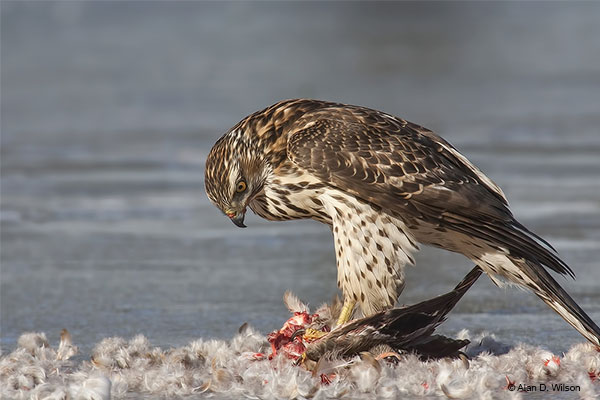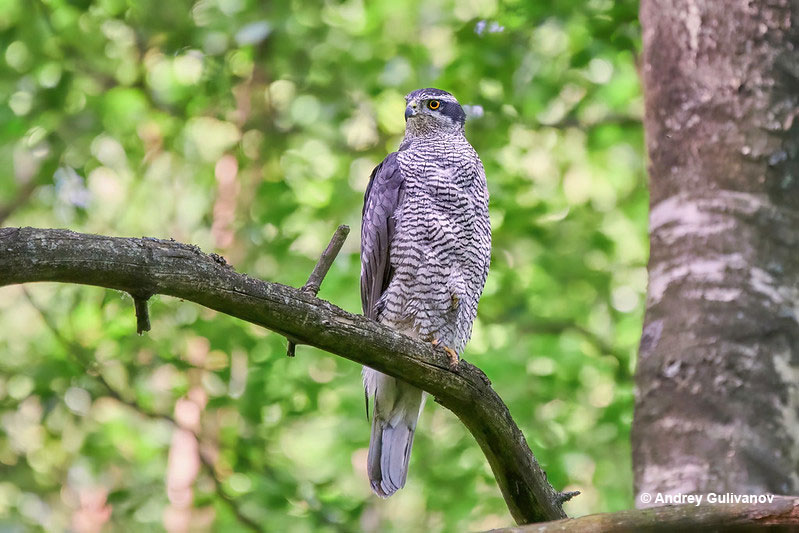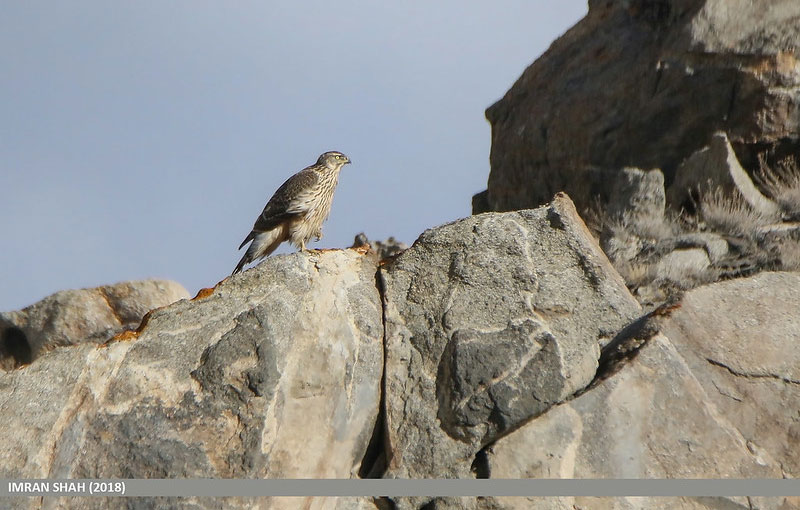The Northern Goshawk is a medium-large bird of prey found throughout many deciduous and coniferous forests of the Northern Hemisphere, with a significant presence in the western United States, including Alaska and western Canada.
These skilled predators are known for their stealthy hunting techniques. Their striking appearance is characterized by a mixture of darker and paler grays.
On this page
Identification
As the biggest hawks in the Accipiter genus, Northern Goshawk’s size places them somewhere between a crow and a goose. Adults have dark gray backs, and pale gray barred undersides. Their dark head is adorned with white eyebrows and orange or red eyes.
There are 9-10 agreed-upon subspecies with slight differences in their plumage, with the northern birds being paler and birds in warmer areas darker. Females are larger than male Northern Goshawks.
Juvenile Northern Goshawks have a solid to mildly streaky brown upper plumage, but the coloration of their underparts can vary from white to cinnamon with dark brown striping. Their eyes are pale yellow, which develops into adult red usually after their second year.
Northern Goshawks’ call is a rapid ki-ki-ki-ki that they may sometimes precede with a kreey-a. The speed and volume of the call depends on the context. Males usually have higher voices, whereas females sound deeper and louder. Females may escalate the call to a scream when defending the nest. They also have calls to beg for or deliver food and to recognize each other.
Food
The specific diet of each individual depends on their environment. Northern Goshawk’s diet primarily consists of birds, such as grouses, woodpeckers, jays, and crows, and small mammals, such as squirrels, hares, rabbits, and rodents.
It may occasionally include fish, amphibians, invertebrates, reptiles, and insects. These carnivores can take down prey up to half of their bodyweight.
Northern Goshawk is a powerful predator with short wings and a long tail that allow it to make quick and agile flights through wooded environments to catch birds and mammals.
It hunts in various woodland habitats, often using speed and obstructing cover to ambush prey, and can also forage in adjoining habitat types.
Although they have also been observed to look for prey while soaring in the sky, the Northern Goshawk is typically a perch-hunter, watching for unsuspecting prey from elevated perches and making short flights to attack.
It can adjust its flight level to remain hidden from prey and engage in tail-chases once a prey item is selected. Hunting success rates are roughly estimated at 15-30%, and most kills can feed the bird for 1-3 days. They sometimes store prey between branches for up to 32 hours, mainly during the nestling stage.
Nesting and Eggs
Northern Goshawks are monogamous and typically mate for life. The male starts bringing food for the female even before eggs are laid, and the female Northern Goshawk either repairs an old nest or builds a new nest. Adults perform aerial displays and vocalize to attract a mate and lay claim over the territory.
The nest is usually built 15-75 feet above the ground on a branch next to the trunk of the largest tree in the nest site. Birds in the east and Midwest prefer maple, oak, beech, and aspen, whereas western birds prefer conifers.
The female first collects twigs and sticks from the forest floor or breaks them off themselves, constructs a cup-shaped nest about 3-4 feet long, 1.6-2.2 feet wide, and about 2 feet high, and lines it with soft bark and green vegetation.
Northern Goshawks breed once a year, and the females lay 2-4, rarely five bluish-white eggs that take around 28-37 days to incubate. Most of the incubation is done by the female, and the male helps by delivering her food. After hatching, the male still provides food but leaves it on a nearby branch.
Parents take care of their offspring until they are about 70 days old. The offspring stay in the nest for about a month and then begin to climb on the nearby branches. They may start flying when they reach 35-46 days of age.
Current Situation
Northern Goshawks range throughout most of North America and the mountains of northwestern and western Mexico. Their populations are more concentrated on the western side and don’t usually reach the southeastern United States.
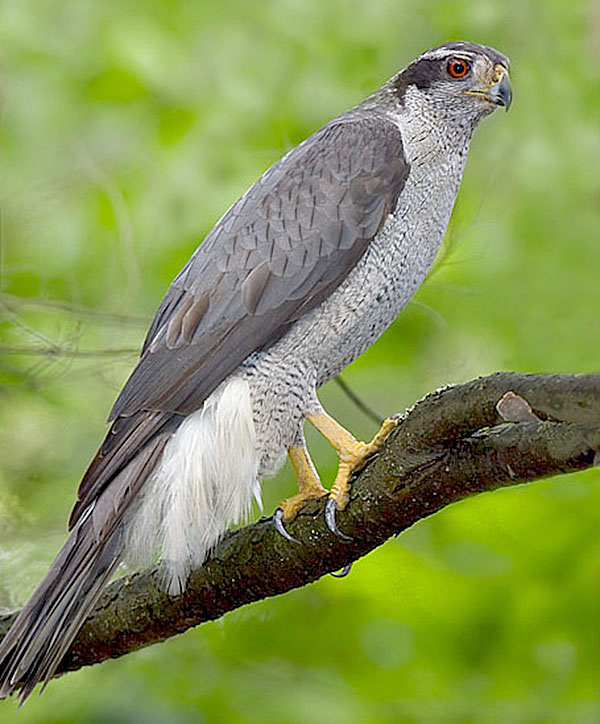
Photograph © Jim Zipp.
Northern Goshawk’s habitats are typically coniferous and deciduous forests from sea level to higher mountains. They prefer unbroken, mature, and rather closed-canopy forests for nesting, but they may also choose to live in relatively open woods or along forest edges.
These birds are mostly year-round residents or short-distance migrants. Younger birds may leave the breeding grounds, and some may move to warmer areas during winter, usually toward lower elevations.
They have an extensive range and population of 1-2,5 million mature individuals and are listed as species of least concern in the IUCN Red List. Nonetheless, their population is facing problems in the form of logging and the subsequent loss and disruption of nesting grounds. These birds are quite sensitive to change and are considered forest management indicators.
Facts
- Within their breeding habitat, Northern Goshawks construct and maintain multiple nests. During the breeding season, they may add fresh conifer needles to the nests. The needles contain aromatic chemicals that function as a natural insect and fungus repellants.
- Northern Goshawks grow up to 25 inches long, which makes them the largest in the Accipiter family.
- Northern Goshawks are very aggressive in defending their nest and offspring. Females will attack any intruders, including humans, and are capable of drawing blood.
- In many cultures, Northern Goshawks are considered symbols of strength.
- In medieval times, the nobility favored Northern Goshawks and goshawks as their preferred prey for falconry.
Similar Species
Northern Goshawks have quite a few similar species, and we’ve decided to introduce four. Some of them are quite similar, so read further to see how to differentiate between them.
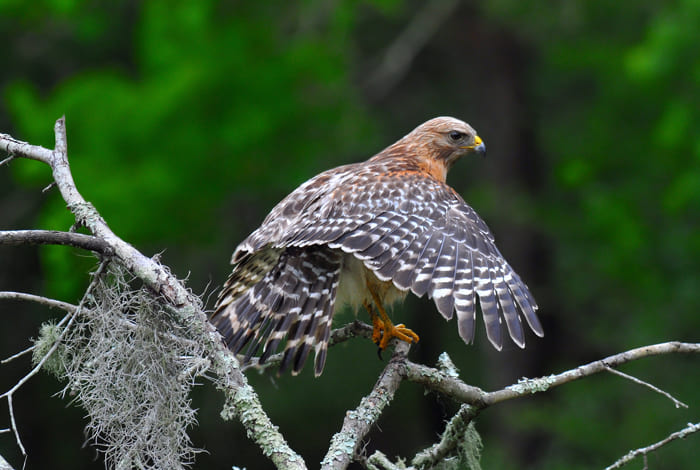
Red-shouldered Hawk
Red-shouldered Hawk
An adult Red-shouldered Hawk and a juvenile Northern Goshawk may appear quite similar with their overall brown plumage. However, Red-shouldered Hawks usually sport warmer tones, and the juvenile Northern Goshawks appear whiter on their underside. A definite tell is their eyes if you can get that close since juvenile Northern Goshawks have yellow and adult Red-shouldered Hawks have deep brown eyes.
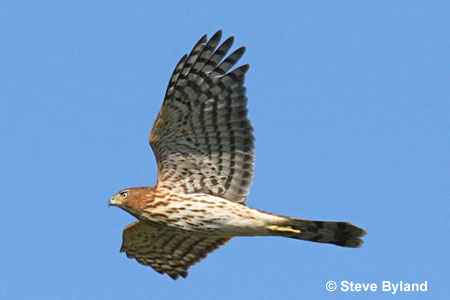
cooper’s hawk
Cooper’s Hawk
Cooper’s Hawk may appear similar at first glance with its slaty gray upper body and barred underside. However, Cooper’s Hawk has dense rusty barring on the underside and is considerably smaller.
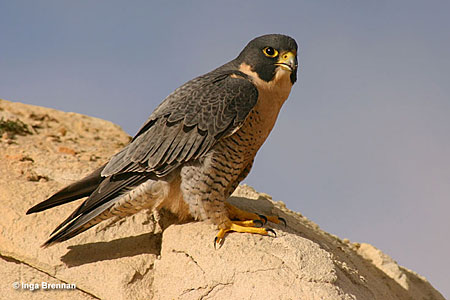
peregrine-falcon
Peregrine Falcon
Northern Goshawks and Peregrine Falcons are quite similar, but there are three key differences.
Peregrine falcons have white breasts with no barring, they have blackish eyes with a yellow eye ring, and they are a bit smaller.
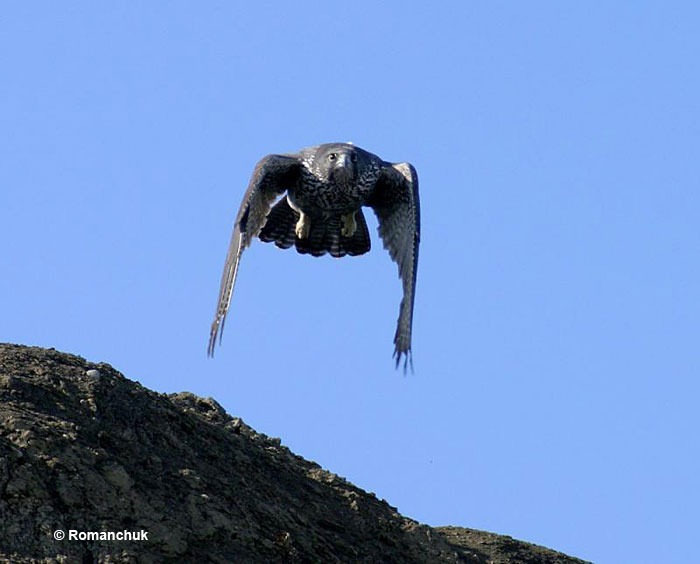
Gyrfalcon
Gyrfalcon
Gyrfalcon’s gray morph can appear quite similar to Northern Goshawks, especially because they’re about the same size.
However, Gyrfalcons can have light banding on their upper plumage, and they have distinct dark eyes.
Learn more: Falcons vs Hawks
Frequently Asked Questions
How do you identify a Northern Goshawk?
Northern Goshawks are medium-large birds of prey with dark gray upperside and pale gray barred underside. You can often see them in wooded areas and recognize them by their kik-kik-kik-kik call.
How big is a Northern Goshawk?
Northern Goshawks are around 20-25 inches long, weigh 22-48 ounces, and have a wingspan of 40-46 inches.
Where do Northern Goshawks live?
Northern Goshawks range almost all across North America and prefer to inhabit coniferous and deciduous forests with a more or less closed canopy.
Why is it called Goshawk?
The name Goshawk comes from Old English Gosheafoc, which translates to “goose hawk”, probably because some of its prey consisted of birds.
Are Northern Goshawks rare?
Northern Goshawks are pretty common and widespread.

